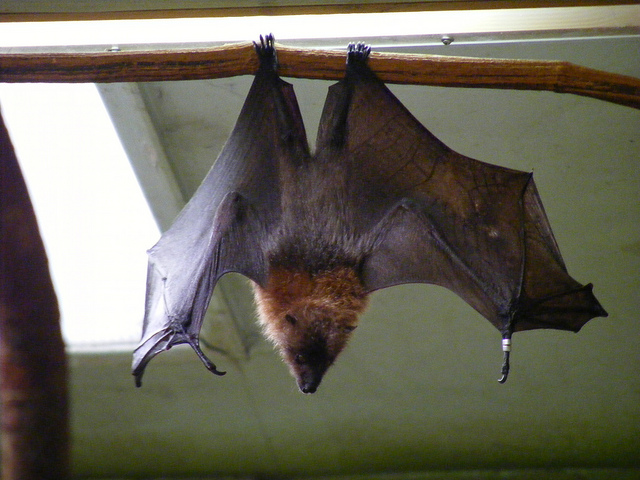Human rabies are almost always fatal.
The good news is, rabies are rarely seen in humans in the U.S.
There are only about one to three cases reported annually, according to the Centers for Disease Control and Prevention (CDC).
Although it's rare, the most common way for humans to contract rabies is through bats, and there's no lack of the flying mammal in the greater Sacramento area.
The Yolo Causeway, the highway connecting the cities of West Sacramento and Davis, is home to 250,000 Mexican free-tailed bats. It's one of the largest urban bat colonies in California. There's so many bats in the area, the Yolo Bypass Wildlife Area actually hosts a bat presentation to showcase the massive colony.
The bats aren't necessarily limited to the Yolo Causeway.
Seven dead bats were found on the UC Davis campus over the past few weeks and three tested positive with rabies, according to the Yolo County Sheriff's Department.
Positive tests for rabies on bats is common, especially in the spring and fall months when they migrate to the area, a Yolo County Animal Services spokesperson said.
There's no way of knowing if a bat has rabies just by looking at the animal. They have to be tested in a laboratory.
Yolo County officials advise people to avoid any contact with bats and to report dead bats or bats with 'abnormal behavior'.
Abnormal behavior for bats includes lying on the ground, being out during the day, or showing up in places they aren't normally found, like a house.
Bats in the home (yes, it happens)
Most people never expect to find a live bat in their home and most people likely won't ever encounter one in their home, but the majority of people who contracted rabies through bats from 1997 to 2006, acquired the virus through a bat in their home, according to the CDC.
The CDC says, people who have found bats in their home have either woken up to a bat bite, or been bitten by a bat while trying to get a bat out of their home. In a couple cases, children have unknowingly been bit in their homes while asleep or they've handled a bat without adult supervision.
It's important to 'bat-proof' your home to prevent any bats from coming in.
The CDC suggests filling any holes larger than a quarter-inch by a half-inch found in a home and using window screens and chimney caps. Attics should be checked thoroughly and draft guards should be placed in doors to attics.

Mexican free-tailed bats, the bats most likely to be encountered in the Sacramento area, weigh less than one-tenth of a pound. Their small size makes it easier for them to fit through smaller holes.
If a bat finds a way into a home, the best thing to do is to leave it alone and call animal services to prevent any risk of rabies exposure.
Preventing rabies
It's better to be safe than sorry.
Bite wounds or scratches from rabies-carrying animals, such as bats, should be taken seriously even if a risk isn't sensed. Symptoms may not immediately appear. In fact, sometimes they don't appear for weeks or months, according to the CDC.
Rabies can cause pain, fatigue, headaches, fever, and irritability. This is followed by seizures, hallucinations, paralysis and eventually death.
Once symptoms appear, death is almost guaranteed about a week later.
If a bite wound is cleaned and treated immediately after exposure, it can prevent rabies.
If a person is bitten, CDC advises they seek a doctor immediately. The doctor will determine whether or not a person needs a rabies postexposure prophylaxis (PEP) which consists of a one time dose of a human rabies immune globulin (HRIG) and four rabies vaccines.
A HRIG is given to previously unvaccinated people. It provides antibodies until the body can respond to the vaccine by actively producing antibodies of its own.
If a person has previously received postexposure vaccinations or a HRIG, they only need two rabies shots.
People who are at higher risk for rabies, such as veterinarians and animal handlers, should be offered preventative rabies vaccines.
Death from rabies only happens if a vaccine isn't received after exposure, according to the CDC.
Many times, if a death occurs, the victim was unaware they were exposed to rabies, according to the CDC.
If a person unexpectedly finds themselves in the same room as a bat, it's important to seek a doctor even if there's uncertainty of a bite. The CDC reports of cases where people wake up to find a bat in their room. A bat bite isn't always noticeable or felt. Children or those unable to speak or communicate are especially at risk.
It's nearly impossible to survive rabies without vaccination.
In 2011, an 8-year-old California girl made headlines after becoming only the third person in the U.S. to recover from rabies without a vaccine. But the case is very unusual.
Bats are not the enemy
Bats serve as a beneficial part of the ecosystem and usually aren't infected with rabies. They are major predators of night-flying insects and serve as pest control in agriculture-rich areas such as Yolo County.
They don't pose any danger as long as they're not approached or handled without training.
The UC Davis campus isn't in any potential danger following the recent discovery of rabid bats.
"We're just letting people know it happened," said Andy Fell, spokesperson for UC Davis. "It's something to be aware of."
Fell said the information about the rabid bats released to the public is meant to serve as a warning for people to be aware.
Even though the Sacramento area has a large population of bats, it's unlikely to become infected with rabies as long as safety measures are taken around bats.


